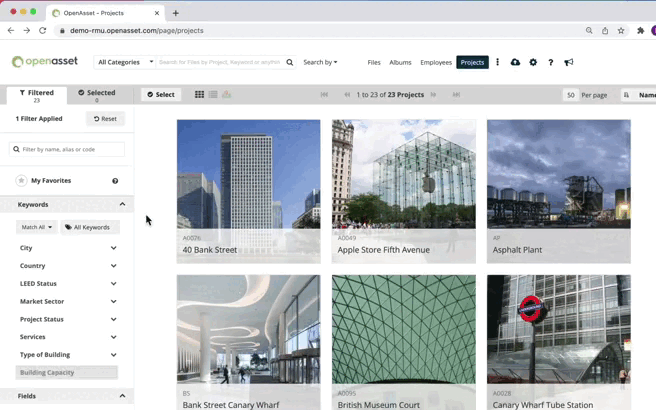No matter if your firm is domestic or global, has one office or ten, or employs 50 people or 5,000, sharing information across your company can pose a continuous challenge. A well-informed workforce is one that is more engaged and more productive, but how can you achieve this? While a dedicated intranet or corporate wiki might be one answer, OpenAsset can offer an alternative (or complementary) option.
While OpenAsset is primarily built to help in the storage, access, and usage of files, its benefits as an information-sharing platform are sometimes overlooked. But with project data, employee profiles, and proposal assets all hosted on one platform, it makes sense that it can offer tangible value to educate and inform your employees. In this blog, we’ll uncover some specific scenarios where OpenAsset can remove barriers to company education, and how this serves to empower your workforce.
Employee onboarding
One such scenario where OpenAsset can help educate is in the process of employee onboarding. When a new employee joins a firm, typically one of their first tasks is to familiarize themselves with the company’s past work. What this entails is dependent on the firm, but generally, it may involve the employee combing through case studies and reports to build an understanding of the firm’s past projects. Most likely there will be too many projects to feasibly learn about, so the employee will be constrained to only read about work relevant to their particular role.
If the employee were to be onboarded with the help of OpenAsset, this process might look different. In the form of OpenAsset, a new employee has a visually appealing database of past projects at their disposal, allowing them to immediately get to grips with the firm’s full capabilities. Because each project overview is easily digestible, a new employee could feasibly learn about a range of projects, while complementing this with full case studies or reports for projects that are most relevant to their role.
Using project filters such as ‘market sectors’, ‘services provided’, and more, a user can proactively search for work that interests them, instead of simply being assigned set projects to read through. This exposure will give the employee a more well-rounded view of the business, increasing their engagement and giving them the confidence to input ideas quicker than they otherwise might have.
Lastly, the employee can of course check out all of the images from each project to gain further insight. They may choose to utilize Ranks to get a quick snapshot of the best available images from each project. Alternatively, they might choose to filter images by ‘build status’ allowing them to quickly visualize the project’s steps from inception to completion – giving them additional context about the project.
Utilizing OpenAsset in this way empowers the user to read through the information at his or her own pace, and allows for continuing education throughout their time at the company.
Learning from colleagues
Another way in which your employees can extract knowledge from OpenAsset is by learning from their colleagues. By searching across Employee and Project data, an employee can view their colleagues’ past experiences and then ask them about their different areas of expertise.
Using an example we can highlight scenarios where this may be helpful. Let’s imagine you’re an architect who’s been put forward for a new corporate office project based in New York. You’ve handled many projects like this before, but you don’t have New York-specific experience and you’re keen to learn about any city rules or regulations. You may choose to research this online, spending hours perusing online articles and forums, potentially going around in circles for your answers. Alternatively, you might prefer to use OpenAsset.
By searching for Projects located in New York, and then viewing the Employees associated with those projects, you can quickly learn who was involved, their roles, and even the number of hours spent working on the project. Once you’ve found someone who might be able to help, you can then message them asking for the information to help you on your way. Not only may this result in a faster search for your information, but you may also receive additional tips and advice from a trusted source. All while making a new connection from within your company. It’s a win, win, win!

Creative reference or inspiration for future projects
An additional way in which users may utilize OpenAsset is to search for inspiration for their upcoming work. If an employee is racking their brains about the design of an upcoming project, they might decide to use other builds as a source of reference. In this instance, they may use OpenAsset to filter on Projects that share similar properties or features to their upcoming build. They may choose to further filter on the Files within, and use the best ones as a guide for success. After all, sometimes there’s no need to recreate the wheel! As in the section above, the employee might then want to contact the colleague who worked on the project to get more context or to learn about their methodology.
Another option is to create a new File Category in your system for reference images. This will give a dedicated space where users can look for inspiration. The Category might host internal photos, such as those taken out and about in the city, or external images, such as those found online or in industry publications.
A centralized hub for documents
Another way in which OpenAsset promotes knowledge-sharing is by making files and documents more widely available throughout your firm. While OpenAsset is most commonly used for hosting images, it is also a great tool to host your non-project files, such as marketing documents, sales collateral, presentation decks, etc. With access to these materials, your employees can get insight into the firm’s tone and language, the value proposition, sales strategies, and more. Alongside general learning opportunities, this can provide additional benefits. For instance, they may be more likely to proactively provide feedback on the documents in use, or they may like to repurpose parts when creating their own materials. Like images, documents can also be tagged with keywords, while more detailed information can be added in the description field. One tactic to ensure these documents are easily discoverable is simply copying key portions of the document’s contents into the description field. More detail on this workflow is outlined in this non-project files blog. Overall, this increased visibility to company documents is likely to improve engagement and leave employees feeling connected to their firm.
Of course, not every asset needs to be shared company-wide. Access Levels can ensure certain files are restricted.
Showcasing your whole portfolio externally
OpenAsset can also be a useful tool for educating those outside of your organization. While in most cases you would only allow access to files via web shares, in certain scenarios you may want to showcase your whole system. For instance, in the case of a merger or acquisition, the OpenAsset platform can be a great way for an external company to learn about your entire portfolio.
Getting Started
While OpenAsset may not replace every aspect of knowledge-sharing across your organization, it can play a valuable role in educating new employees, connecting them with their colleagues, providing inspiration for new projects, and more.
If you’re interested in learning more about how OpenAsset can double up as a knowledge base, feel free to contact your dedicated Customer Success Manager or reach out to support, here.



